Last week, the Stanley Cup Playoffs concluded with the Tampa Bay Lightning crowned Stanley Cup Champions. With that comes the dawn of a new offseason. This year brings a unique challenge to NHL teams. No, not the flat cap: the expansion draft! In December 2018, the NHL approved Seattle’s bid for an expansion team, now named the Kraken. Coming only four years after the Vegas Golden Knights built a team through the exact same process, Seattle has both the benefit of recent history with Vegas’ draft to draw on and the (potential) downside of NHL teams improving on their past decisions. This expansion draft will have the same rules as the 2017 draft, which we’ll cover below in more detail. With Vegas’ exempt status, this draft will be the exact same as it was 4 years prior – only the available players are different.
I’ll admit that I was pretty much dead wrong about Vegas’ expansion draft given their incredible results over the past 4 seasons. But honestly, their draft itself was fairly uninspiring (look at their picks and tell me you see a perennial Conference finals team). They succeeded in large part due not necessarily to their draft, but rather a good deal of luck (William Karlsson, Shea Theodore, Alex Tuch, Marc-Andre Fleury), the poor decisions of other teams (Florida, Anaheim, Minnesota among others), and solid free agency acquisitions in the years following their debut (Mark Stone, Max Pacioretty).
Regardless, I thought the Golden Knights would be on the level of Buffalo Sabres ’14-15 terrible. Now, this was years ago when we still ran a Minnesota Wild stats account, and we didn’t have a big fancy website… live and learn right? However, given the improvements in the tools we now have at our disposal (www.evolving-hockey.com), we thought it would be a fun exercise to “draft” our own 2021 expansion team. Along with the publication of this article, we have released our GAR projections for all eligible skaters heading into the ’21-22 season (found here). It seems only natural for us to compile protected lists, exempt lists, and pending UFA lists, join these onto our projections, filter these results down to potentially exposed players, and “draft” our own team.
Well that’s what we did. It was actually a lot more difficult and time consuming than I thought it might be. Almost entirely because, if you weren’t aware, there are a LOT of people who play hockey close to a professional level that teams have rights to. And while the rules in the expansion draft aren’t necessarily the most complicated, two people getting all of this in line was very time intensive. Here’s a quick refresher of the rules for the 2021 Seattle Expansion draft:
Logistical rules
- The expansion draft will take place July 21, 2021
- Each team has to submit their lists of protected players by July 17, 2021
- The Vegas Golden Knights are exempt from this draft (Seattle will not draft one of their players)
- Seattle will be granted a 48-hour window prior to the draft to sign any pending free agent (both restricted and unrestricted free agents). If Seattle signs a player during this time, the team that lost a player during this signing window will not have a player selected from their roster during the draft
Protection rules
- “All players who have earned two or less professional seasons at the end of the 2020-21 season, as well as all unsigned draft choices appearing on the teams reserve list, will be exempt from the upcoming expansion draft.”
- “Players with potential career-ending injuries who have missed the previous 60+ consecutive games due to an injury, do not meet the criteria set forth by the league in respect to the minimum exposure requirements for players, and in certain cases these players may even be deemed as exempt from the Expansion Draft selection process.”
- Each team will be able to protect either 7 forwards, 3 defensemen, and 1 goaltender -OR- 8 total skaters and 1 goaltender
- Teams are required to use a protection spot for any player currently under contract with a no move clause (NMC) including limited no trade clauses. Any player may waive their NMC to be exposed in the draft
- Each team must expose two (2) forwards and one (1) defenseman who are under contract for the ’21-22 season AND have played at least 27 games in the ’20-21 season OR more than 54 games in the ’19-20 and ’20-21 season combined
- Note: skaters who are restricted free agents (RFA) in 2021 but meet the games played requirement do not meet the exposure requirements
- Teams must also expose one goaltender under contract for the ’21-22 season or who will be a restricted free agent in 2021
Pick rules
- Seattle must pick one player from each team unless they sign a player during the 48-hour window as covered above
- Of the 30 players selected (one from each team excluding Vegas), 20 of these players must be under contract for the ’21-22 season
- Seattle is required to select a minimum of fourteen (14) forwards, nine defensemen (9), and three (3) goaltenders
- The total ’21-22 salaries (cap hit per year) of the 30 players selected must add up to between 60% and 100% of the ’20-21 salary cap ($81.5 million). This does not include selected RFAs with an expiring contract in 2021
Sources: CapFriendly, Wikipedia
The Process
As I mentioned above, the goal here is to “project” who we would select based on the available/exposed players. This requires a few steps to get to the point of properly “exposing” the right players, excluding players that are not eligible, and checking a few things to make sure everything makes sense. Additionally, we are only using GAR projections for this process. We do have xGAR projections at our disposal (they will be added to the site soon). Overall, these are quite similar when it comes to selecting players, and none of the picks we’ve made change. Here is a quick overview of our process:
- Protected lists were determined for every team with the help of numerous people: writers, fans, The Athletic articles, random blogs, etc. My goal here was to try and determine the “consensus” or “standard” protected list for every team. To be clear: none of these lists were based on what “we” thought teams should do. I have to give a big shoutout to anyone who helped when I pestered in DMs as well.
- Exempt lists were determined based on CapFriendly’s incredible Expansion Tool. I can’t stress enough how great this tool is. We likely would not have been able to complete this exercise without their site. Additionally, CapFriendly’s Depth Charts were an incredible resource during this process.
- Other than a few players (more below), all pending UFAs were removed from the process. Other than a handful of the “best” UFAs this season, it makes little sense for a team to protect a pending UFA or Seattle to use a draft pick on one of these players.
- Once these three groups of players/lists were compiled, I joined them onto our GAR projections, filtered down to all players who were NOT on one of these lists, and ranked available players by their projected GAR for next season.
Now, there was a good deal of trial and error here to not only select the “best” players based on our projections, but to do so in a manner that was also entirely compliant with the expansion draft rules laid out above. Because of this, there is still a possibility we made a mistake somewhere, but having triple-checked everything, I’m pretty sure the team we arrived at is compliant, but please don’t hold it against us if something is off or wrong. Also, we don’t have the resources to ensure we’re compliant since we are, unfortunately, not an NHL organization.
The Data
We’ve made our protected, exempt, and exposed lists available here. Please feel free to use these if you’d like to try this out yourself. This includes three tabs with the above data. Here is a quick summary of the various players that fall into the groups above:
- There were 578 players exempt from the draft based on CapFriendly’s exempt lists. I have to admit that I entered every player manually, so it’s possible this number could vary a bit.
- Based on our research, we believe Nashville, Tampa, and Anaheim will utilize the 8 skaters, one goalie option for their protection lists. All other teams will protect 7F/3D/1G. This yields 324 players who are protected from the Seattle expansion draft.
- There are ~325 pending UFAs in 2021. Of these, only Dougie Hamilton (CAR), Gabriel Landeskog (COL), Adam Larsson, (EDM), and Phillip Danault (MTL) are protected.
- The total number of exposed or draft-eligible players in our dataset is 258. Nashville has the most players available/exposed (13), Minnesota has the fewest players exposed (4). This number is dependent on the number of players that played a time in the ’20-21 season, or otherwise have projections for the ’21-22 season.
- It is likely we may be missing a few players here, but these players would be those who have played enough time to not be exempt while still being unprotected. This group, based on everything we can see, consists of almost entirely AHL/fringe-NHL players still in their early 20s or players that missed the entirety of the ’20-21 season but are not considered exempt (in another league, long-term injury not considered career ending, etc). It is improbable these players will be in consideration by Seattle, but there is a chance.
The Draft
Our process for selecting players was relatively straight-forward. First, we started with goalies. After we filtered down to the available goalies, we were left with only 20 goalies that were exposed (again, only goalies with prior-season NHL playing time were left). As some of you may remember, we did not do projections for goalie GAR in the past, and we did not do them this year either. However, we utilized a combination of the player projection model we use for our game prediction model along with a simple age-adjusted GAR projection model to identify the strongest goalies available. In addition, the 3-goalie requirement per the expansion draft rules implies a typical selection from a new team: two NHL goalies (A/B), and a young or AHL-ready goalie with future potential. There is also the balancing act of goalie vs. skater and which is more valuable from a single team. In certain cases, the exposed players from a given team were either so weak or uncertain (Vancouver), that picking a veteran goalie like Braden Holtby with 1 year left on his contract (plus the previous rumors re: Ron Francis) makes a lot of sense. Identifying the goalies that Seattle may pick removes three teams from the rest of the draft up front.
After the goalies were selected, we sorted the available/exposed skaters by projected GAR/60, and then compared the top-5 players for all teams. There actually weren’t as many “close” picks as I thought there would be heading into this. For about half of the teams, the pick was clear. For teams that had several good options (Tampa Bay, Pittsburgh, Washington, Colorado), we opted for players with more projected TOI (and in turn generally less uncertainty) over those with low TOI projections but potentially higher GAR/60 projections. It’s important to remember that no team is (likely?) exposing a “grade A” prospect per se. Or at least they’re not exposing a younger player that isn’t at least somewhat marginal or unproven. Almost all of these players are either exempt from the draft (Adam Fox, Quinn/Jack Hughes, Kirill Kaprizov) or will certainly be protected by their team (Cale Makar, Andrei Svechnikov, Elias Pettersson). As you’ll see, we did pick a few prospect-type players from various teams, but almost all of these players were picked because A.) their team had relatively few (read: poor) options elsewhere and B.) they fit into the 30 players the rules require.
Given this process was fluid, some of the picks here are not as objective as we thought they might be going into this exercise. But this isn’t due to bias or personal feelings about a player or team’s situation – hell, half of the players I’ve hardly heard of (a joke but not that far off). Really there were a decent number of teams whose options were, simply, not good. To the point where it almost felt like Seattle might just want to pass on selecting someone from that team (future rule/option for expansion teams??). But that would be silly, I suppose. Anyway… without further ado, here is your (well, our) Seattle Kraken Expansion team:
![]()
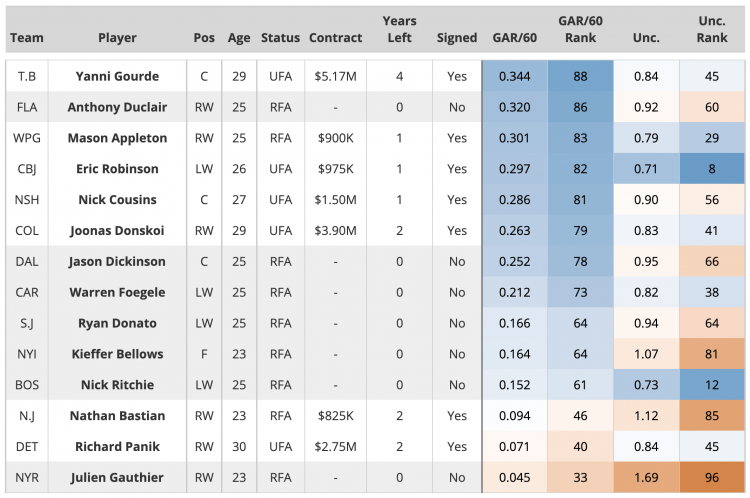
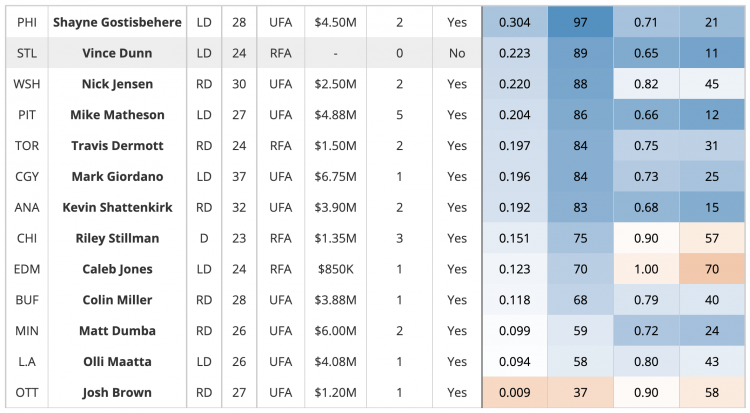

Alright, let’s talk about some of this. First, we’re using GAR/60 projections, corresponding uncertainty figures, and ranks for both in the tables here. We generally opted to pick players that had higher TOI projections (read: more likely to play) than those who did not if the decision was close. So while we’re only displaying the rate version here, it can also be assumed that the projected raw GAR for each is the “best” or highest as well from each team. We opted to focus mostly on the rate version here as moving to a brand-new team with no prior history is a very uncertain environment. We can’t know how Seattle will deploy these players, so relying on their TOI-influenced raw GAR projection is less ideal. Who knows, they may opt to try out previously low-deployment players in high-deployment situations. The ranks (and conditional color formatting) are created comparable to the rest of the league per position.
The uncertainty figures are based on our 10/90 bound uncertainty models for every component. In our system, every projection component in rate form has a point estimate (the projected number) as well as corresponding 10% and 90% uncertainty models that attempt to give the range a player will likely fall within – we expect 80% of the projections to fall within this range. A higher uncertainty number means there is more variance in the projected GAR rate and vice versa. We’ve added ranks for both the projected rate and uncertainty as a reference.
As I’ve mentioned previously, the defensemen options for Seattle are much better than the forward options. Given that the vast majority of teams will take the 7F/3D/1G option, this makes sense as less defensemen are protected overall. In turn, forwards (especially centers) are much more valuable in this draft than any other position.
Additionally, I should note that we did not attempt to balance or optimize the Kraken’ future salary cap outside of the requirement for their first year. As I’ll cover below, there are a few players who may have the highest projected GAR going into next season but whose contract may for one reason or another be less than appetizing. We’ll cover this a bit more below, but overall the choices don’t change much. There are already a decent number of quality players with only 1-year remaining who will be UFAs after the ’21-22 season. It remains to be seen how Seattle will handle their debut season from a cap standpoint, but I figure keeping their future salary cap situation lower/less restrictive long-term is more likely.
Interesting teams:
Tampa Bay: In my opinion, the Lightning will likely be hit the hardest by expansion. Whether it be through the draft or a forced trade ahead of the draft, it’s hard to see them coming out of July 21st unscathed. Now, does that mean they’ll be worse? Well, probably. They’ll still be quite good though. Right now, Yanni Gourde is the clear pick for Seattle. Not only is he a center among a very underwhelming group of exposed players, he has the highest projection among all players (both rate and raw GAR). However, if Tampa does indeed opt for the 8/1 protection option, which it seems like they might, I can’t imagine Gourde will be on the team once the draft comes around. We believe that electing to protect 7 forwards and 3 defensemen, exposing McDonagh, would be the best option for Tampa. However, the Lightning have enjoyed a steady core on the backend over the last couple of seasons and will likely want to protect that. Either way, it seems unlikely they’ll be able to keep contracts like Gourde’s, so he may be gone either way. If Gourde is gone before the draft, Mathieu Joseph and Alex Killorn are the next options based on our projections. Both players are quite good and would make great selections for Seattle.
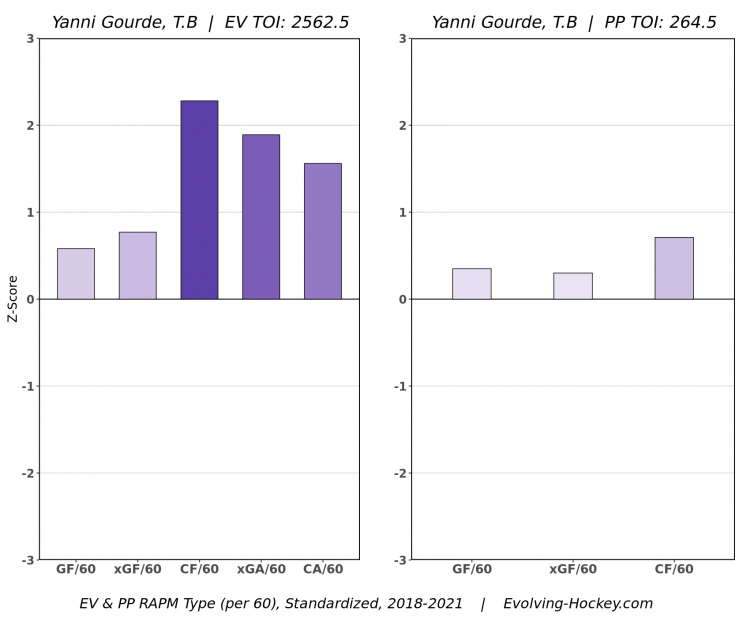
Philadelphia: Some people may be surprised by Gostisbehere’s projection here (given he passed through waivers this year and the Flyers haven’t been able to find a trade partner), but basically everything we have at our disposal indicates he’s a top-tier D aside from whatever the hell is going on in Philly. JVR or Voracek are the next options for PHI, but they’re far behind Ghost.
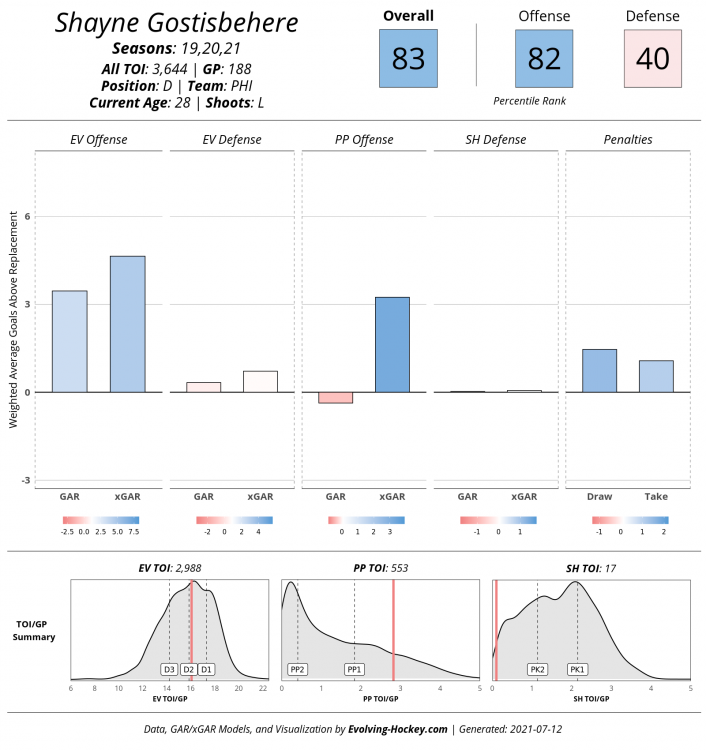
Pittsburgh: Another interesting choice here is Mike Matheson. Pittsburgh has some interesting options, but Matheson projects to be the best player next season of those exposed by the Penguins. The next options are Marcus Pettersson, Zach Aston-Reese, and Jason Zucker. There have been some rumors re: Zucker, especially considering his somewhat mis-matched placement within PIT’s lineup, along with his veteran acumen and locker room value. To me, he seems like great captain/alternate material, but Seattle has a lot of those options. If Seattle doesn’t want to take on 5 more years of Matheson, Pettersson seems like a totally viable option as well.

Washington: The Capitals have possibly the most options for Seattle. They also have the most ambiguity in who they’ll protect. Daniel Sprong seems like a better option for protection over Conor Sheary, but it’s entirely possible that we may be wrong there. Either way, Jensen’s projected GAR rate (when centered around position) is the highest of those available, while Conor Sheary is a close second (and has the higher projected raw GAR heading into next season). Sheary’s contract is the same length and $1M less, and the forward depth is lacking in this draft, so I could absolutely see Seattle taking Sheary here. Vitek Vanecek is another enticing option at goalie, so keep an eye out for him as a possible goalie selection.
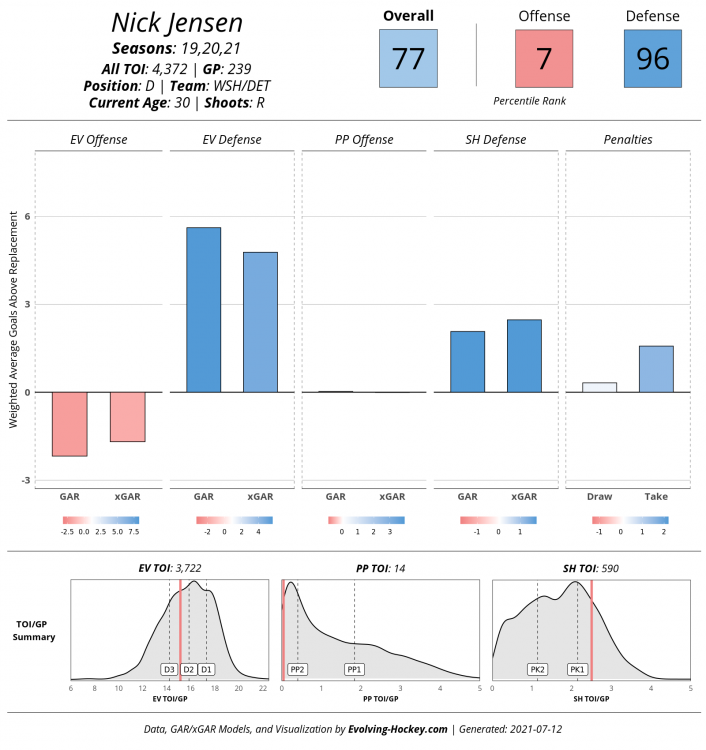
Colorado: if Erik Johnson waives his no move clause, the Avalanche really don’t have a problem. If he doesn’t, one of Devon Toews or Sam Girard will be exposed, which oh boy. I have a hard time imagining a scenario where that happens. Assuming Colorado does something with that NMC, Donskoi is our pick here. However, Seattle has options if they want to explore them. Both Ryan Graves and Logan O’Connor (who actually has the highest projected rate among exposed players for COL) could be interesting picks if Seattle sees something there.
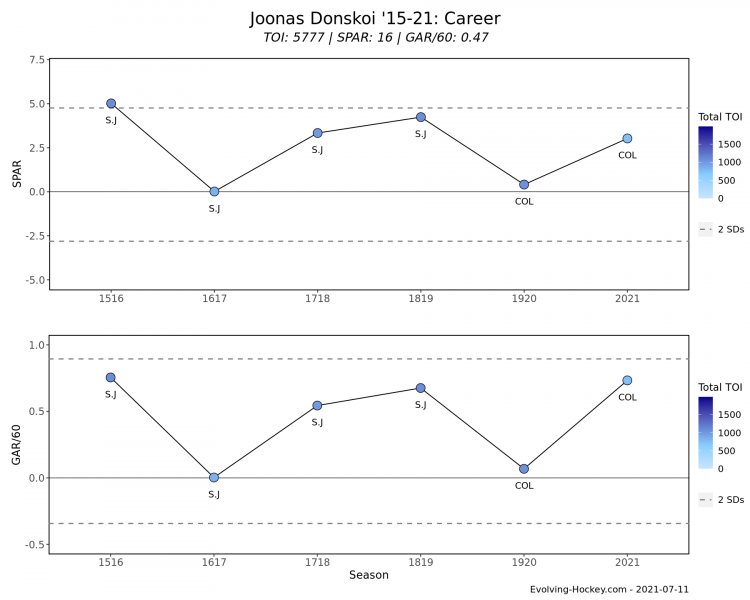
Minnesota: I wouldn’t say the Wild have “issues” necessarily. However, it is noteworthy that the “obvious” pick in Matt Dumba is not our highest projected player. Victor Rask, surprisingly, takes that prize. The Wild only have 4 players exposed who had time in the NHL in ’20-21, so they’re already limited there. I wonder if Seattle likes Rask here, due to the lack of center depth, and maybe angles a pick out of Minnesota in the process for not taking Dumba or Soucy? Something to watch out for.
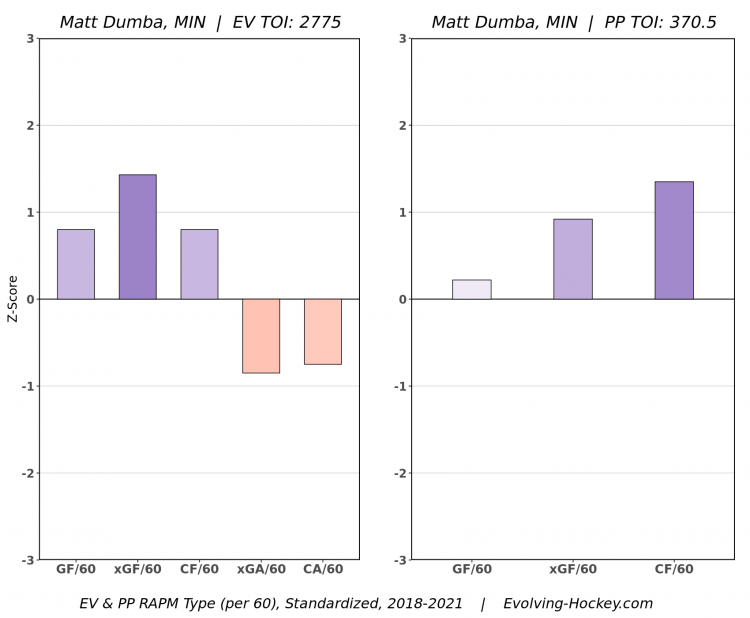
Ottawa/New York Ranger/Vancouver: these three teams have the worst options in terms of exposed players based on our projections. This makes it somewhat difficult for different reasons. I may eat my words here, but I have a hard time believing any skater taken from these three teams will have an impact for Seattle. NYR is a bit different since there is still some “prospect” status to Gauthier, and we’ve gone ahead and selected Holtby (Vancouver) as one of Seattle’s goalies for various reasons – one being that the Canucks just have nothing else to offer. I don’t know who Seattle will take from these three teams, and frankly I don’t really care.
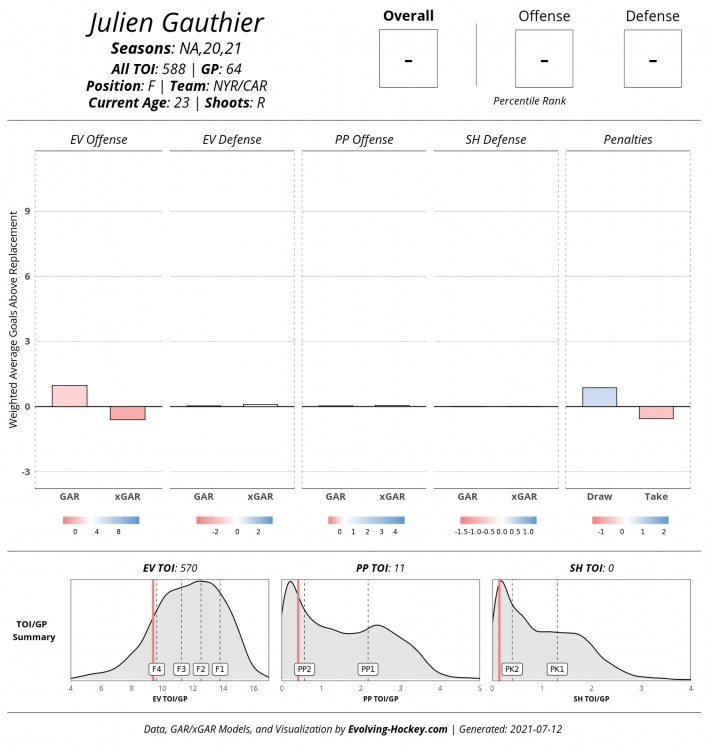
Anaheim: we’ve projected Shattenkirk as the pick here based on both his projected GAR (position centered rate specifically) and contract (2 years at $3.9M). However, Adam Henrique is another player that may make a lot of sense. He’s a top-5 center among those exposed and has been mentioned as possible future-captain material for the young Kraken. The only deterrence may be the 3 years left on his $5.825M deal. Shattenkirk is still a fantastic player, brings a similar veteran presence to the team, and likely slots in as a 1/2 D on the right side.
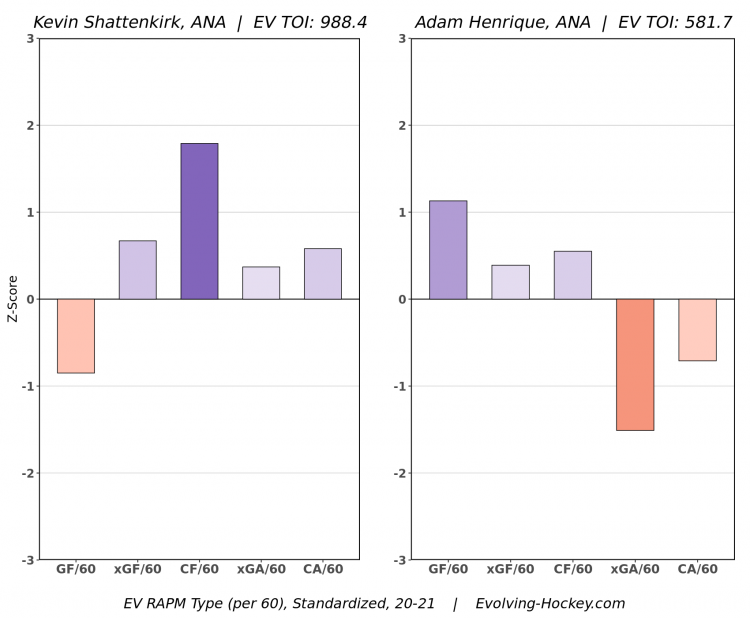
St. Louis: it appears the Blues aren’t going to protect Vince Dunn. What the hell? Additionally, we’ve opted to remove Tarasenko from the Blues’ protection list due to his recent trade request.
Chicago: De Haan and Stillman are very close, and De Haan projects slightly higher. Given how close they are, age, and contract, we opted for Stillman in this spot. It’s a mostly marginal pick.
Dallas: Anton Khudobin (goaltender) is a viable option for Seattle. However, with Jason Dickinson exposed as a solid center option along with Khudobin’s age, we opted for Dickinson.
Calgary: they can’t do Gio like that. But the next best option is Milan Lucic. So…
Final Thoughts:
We did not do an in-depth preview like this for Vegas, so my instincts may be a bit off here, but it seems the choices for teams are not as hard as they were 4 years ago. I’m sure a few teams are still going to make poor decisions, trade players and/or picks they shouldn’t to protect players they should just let go unprotected. It’s still relatively early, and I guarantee you a few of the players we’ve picked will no longer be available once protected lists are due July 17th. If it’s feasible, we’ll try and update this as moves happen or players become unexposed – likely as an addendum below.
Lastly, we should mention that none of this was done from a “scouting” or “team construction” view. We could’ve possibly optimized this process further by making our selections with balance in mind. That is: we chose the “best” players based on our projections without focusing on what those players were “good” at. The next step here would be to attempt to balance the team by skater components (EV, PP, SH, penalties, etc). However, GAR at its base level is about overall value. Where that value comes from ends up, in theory, contributing to a player’s ability to help their team win games. But within the framework of an expansion draft, our approach was similar to most drafts: you take the best player available.
Again, we need to thank CapFriendly for their amazing site. Without it as a resource this article would’ve been significantly more difficult to write.
Reminder links:
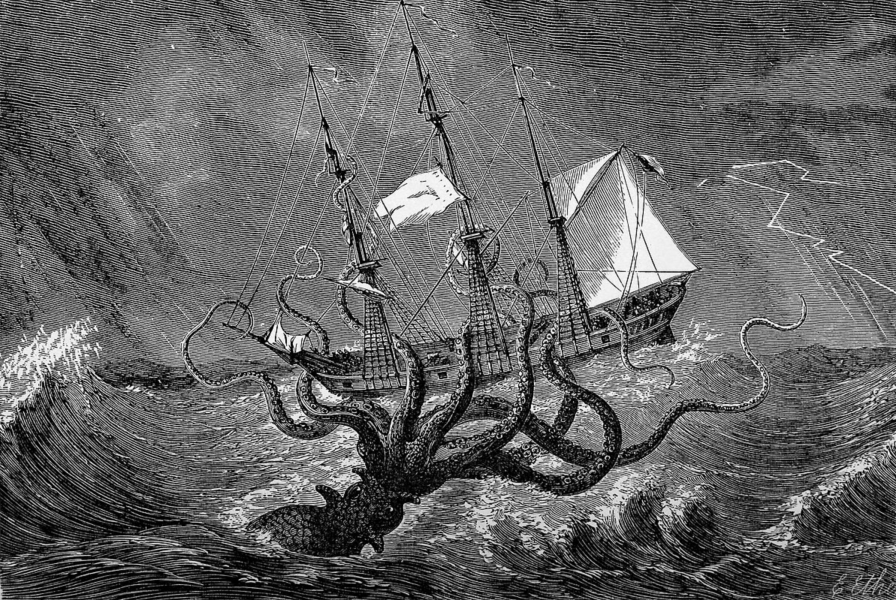
As a Red Wings fan I would jump through the roof if the Kraken took Panik. More cap space for us! I mean I would go for Svechnikov, who was 4th or 5th in Points Per 60 on Detroit behind Fabbri, only 25 years old with some skill and decent xGAR numbers for a guy who barely played.